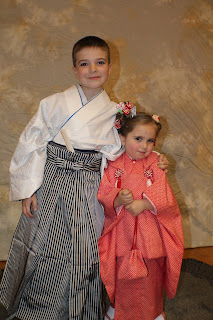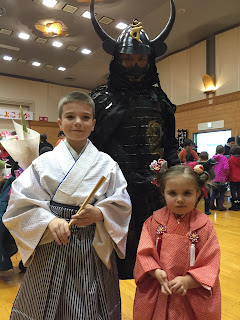The most exciting part was learning how to put on a kimono. They had several people there to help dress all of the guests who came to the event. J and A were so excited when it was their turn. Unfortunately J was in a different room so I was unable to watch the process of layering each of the important pieces in a boys kimono. I was lucky enough to watch A's process though.
I had no idea that there were so many steps to putting on a kimono. It is truly a special experience.
The first step to wearing a kimono is putting on the Nagajuban, or under layer. This is used to help reduce the amount of times you have to wash the kimono. It's basically the equivalent of an undershirt. I would have been happy if this was the only layer she wore. It was so pretty and had a gorgeous geometric pattern. This layer is only shown at the collar once the kimono is put on.
As I watched the lady tie on the Datejime (Koshimhimo for boys), my eyes began to get a little wet. I was watching my two year turn into a little lady before my eyes. As the lady wrapped the sash around her Nagajuban, I had visions of someone helping her with her wedding dress. Yes, this will be WAY down the road but it quickly flashed before my eyes.

The next step was putting on the kimono. A's kimono was very similar to her Nagajuban but it was made of silk and had a sturdier texture to it. Our Japanese lady took such care in making sure that each layer overlapped in the correct area. A watched her with pure contentment and the feeling was reciprocated.
There is an order that must be followed when putting on a kimono correctly. Care and precision are used each step along the way. As the kimono was wrapped around A, I glanced around the room at all of the women and children that were being draped in these beautiful silk kimonos. It was like looking at a bright Asian inspired rainbow. The colors varied from reds and oranges to blues and greens. Each pattern was unique and completed each woman/girl perfectly. Tables were filled with different selections, waiting for their special match to walk through the door.
The next step was to put on the obi, or outside wrap. A's obi was simple and more flexible than the woman's obi. This is a wide silk outer sash that helps hold the kimono together. It is also a decorative piece that is tied in a complicated knot/bow on the back of adult kimonos. This accessory pulls the piece together and truly makes it complete.
With flowing sleeves and plenty of layers to keep her warm, A was ready to head over to the hair department.
Not so fast.....almost done but not yet.
The last step was reserved for her feet. First, A had to put on "funny socks" called Tabi. These socks were in the shape of a foot with a big toe hole and another wide hole for the rest of her toes. A was not sure what to think of these funny feeling socks. There is no elastic and the standard color is white. A quickly got used to the sock but struggled with the formal sandal, Zori, used with kimonos. She had a difficult time scooting along when walking and I ended up holding them for her most of the time.
J wore the exact same layers but designed for boys. His shoes were called hakimono and looked very similar. His shoes had more of a bamboo feeling to them.
On top of these 4 layers of clothes, J also had a hakama, skirt like layer, that helped polish off his look. My little guy looked so grown up. My eyes began to water again (don't judge, I'm a sappy mom). Inside his hakama was a fan that he couldn't help but show off whenever possible.
Buddy, you look so grown up. Did you have fun?
Mom, this thing is super hot and heavy....but it's kinda cool too.
I can only imagine how warm they must have been. 4-5 layers of clothes and unique footwear....I'd be warm too. I later learned that there can be up to 20 layers in a kimono. The wedding ones are very detailed and have many layers of meaning.
The very last step for A was getting her hair done. A is very good about sitting so I can braid her hair like Anna from Frozen but always complains when I brush. Not today...today, she sat like Mulan in that chair. She carefully watched as her beautician wrapped her hair around a wire mesh and put different colored and shaped accessories in her hair. Several flowers and chimes were put in and out of her hair until the perfect balance was met.
My sweet little maiko was ready to go strut through the hallways and get her picture taken.
This was an amazing experience and one that I look forward to doing again as a complete family of five. We all learned so much about the pride, effort, and detail that goes into putting a traditional kimono on.
To top off this unique experience, my children also got to get a picture with a Samurai. They were in true disbelief as he snuck up behind them...stealthy as a ninja.
It was truly a day to remember and one for the books. Another memory logged into our Japan journals.










Wow! How great that the children were fitted so nicely! They look beautiful in the outfits! Who knew of so many layers. What a great experience for you all!
ReplyDeleteSo interesting! I'm sure this is something you and your children will remember for a long time!
ReplyDeleteI had no idea there were so many layers to the kimono. Your kids are darling! What an education for all!
ReplyDeleteArthur Golden includes so much about the traditions and importance of the kimono in his wonderful book, Memoirs of a Geisha. Your children look wonderful and what an amazing experience!
ReplyDeleteArthur Golden includes so much about the traditions and importance of the kimono in his wonderful book, Memoirs of a Geisha. Your children look wonderful and what an amazing experience!
ReplyDelete